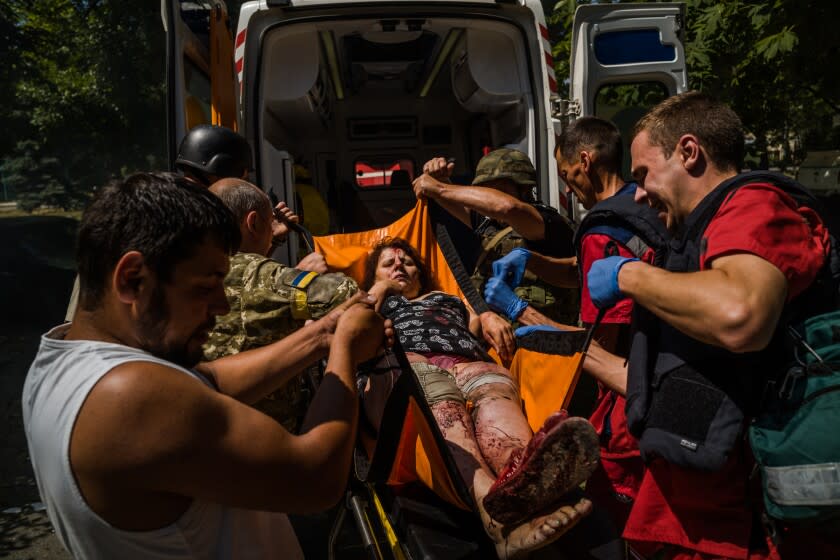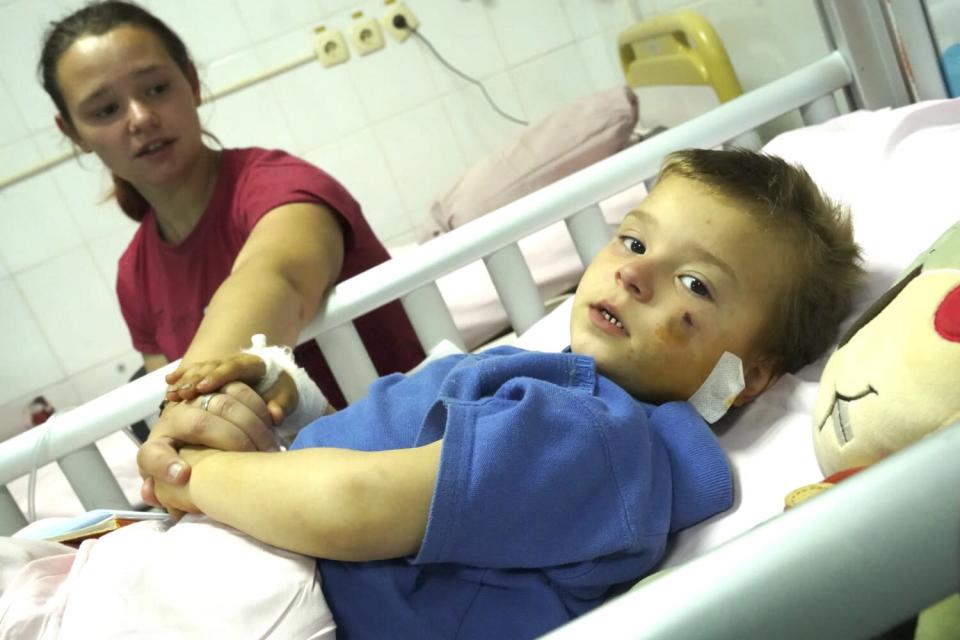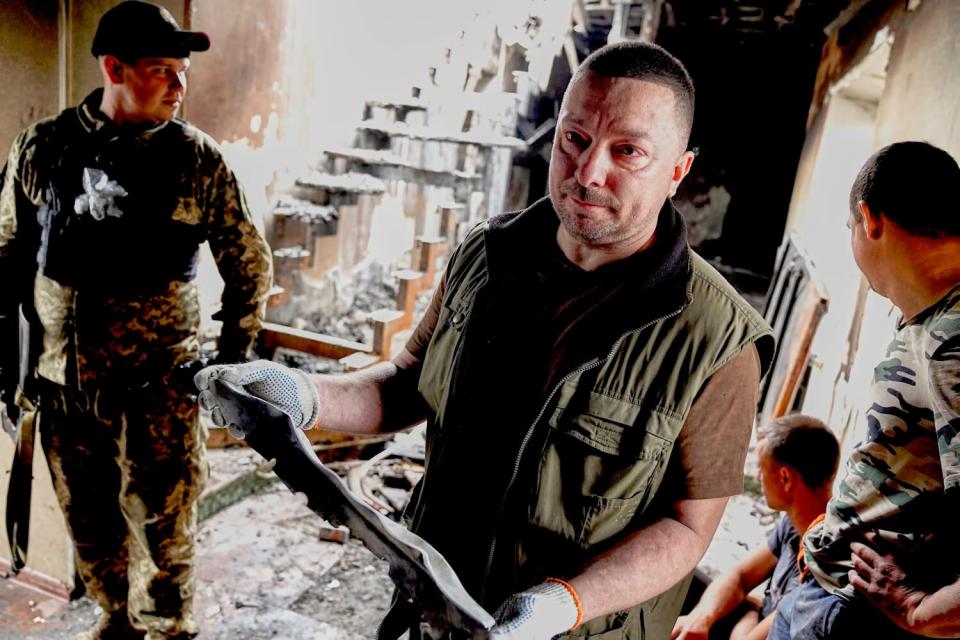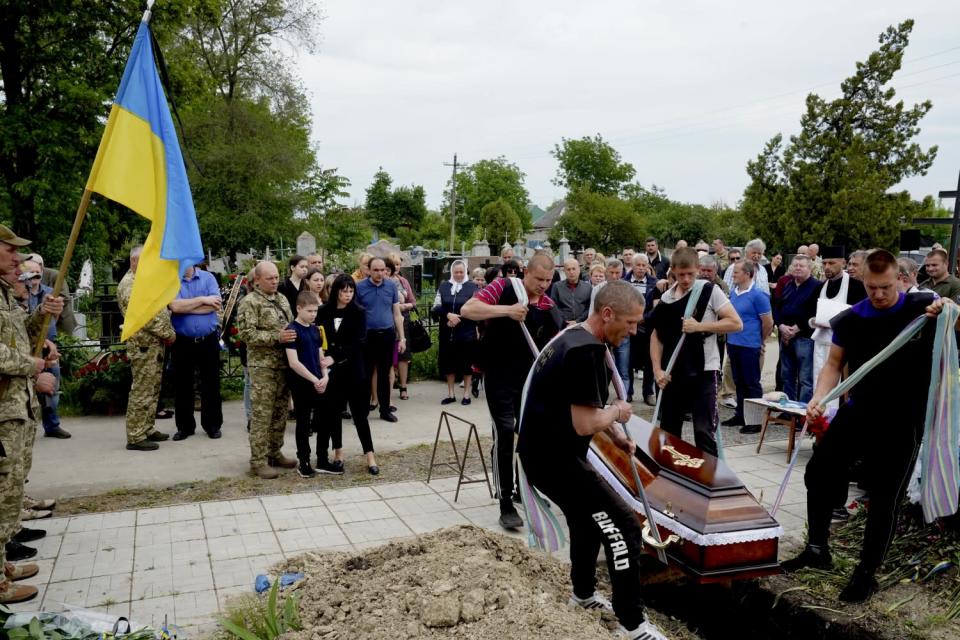
Ivan tended to see the bright side, even as Russian soldiers inched closer and shells pounded his home village of Studenok.
“Everything will calm down,” he assured his young wife, Polina. “It will stop. Everything will be OK. We will not get hurt.”
A farming hamlet of 1,200 people in eastern Ukraine, the village was a casualty of geography: It suffered intense bombardment from Russian forces sweeping toward the Donbas region. That ferocity intensified in late May, when the ground shook and villagers ran for cover, many darting through smoke plumes and into cellars.
“It started at 1 o’clock in the afternoon,” said Polina, 25, who asked that her family’s last name not be used for security reasons. “Three shells hit our garden. Another one hit not far from the hen house. Another one hit where the dogs were. They were killed.”
Polina picked up her toddler daughter and bolted with others toward a neighbor’s house, which had a basement, offering some semblance of safety. Her mother-in-law scooped up Polina’s son Denis, 3.
“A shell landed next to them and exploded,” recalled Polina, speaking outside a hospital in the east-central city of Dnipro, a Soviet-era center for nuclear and space industries that has become a hub for the ever-growing ranks of those displaced by war. “I could see only black smoke, and hear people screaming.”
Polina helped her injured son and mother-in-law to reach the cellar, which everyone knew could — in war’s randomness — become either refuge or tomb. It was an accepted gamble: What else could one do in a ravaged land where fresh graves multiplied and civilians were in the crosshairs?

After a brief respite, Polina said, the barrage on Studenok resumed. A rocket set a neighbor’s roof ablaze, threatening to ignite the house where the young mother and her family were sheltering. Polina’s husband exited the cellar amid the barrage. He went looking for water to douse the fire.
“He didn’t even make it to the yard,” Polina said of her husband. “A shell hit nearby and killed him.”
She fought back tears as she recalled the moment.
“We washed his body, changed his clothes,” she said.
The next day, Ukrainian troops evacuated those remaining in the shelter — five adults and five children. Left behind was the body of Ivan, the cheerful optimist. He was 30.
“I really don’t know if they ever buried my husband,” Polina said of the soldiers. “They promised to do that.”
Her son Denis underwent surgery for shrapnel wounds to his leg, shoulder, face and torso. He was expected to recover, said Polina, who was staying with him at a hospital in Dnipro. “Whenever I am around, he is calmer,” she said.
Her other children — the toddler daughter and sons ages 5 and 6 — escaped injury and were placed temporarily at a nearby church. In a bid to cheer them up, aid workers arrived with balloons; two of the balloons burst. The shell-shocked kids ran and hid.
::
The war in Ukraine, now in its fifth month, has become a relentless campaign of attrition. Each side daily bludgeons the other with artillery barrages that have killed hundreds, forced millions from their homes, divided families and reduced villages, towns and cities to piles of debris. The Russians — more heavily armed — advance in spurts, pushing the front lines farther west.
It’s an almost five-hour drive east from Dnipro past grain fields, mining works and villages to Kramatorsk in the Donetsk region, one of two provinces that make up the Donbas. Kramatorsk, once home to 150,000, is now a garrison town where Ukrainian troops billet in abandoned apartment blocks and hope to thwart the steady Russian advance. Distant detonations echo across the land.
“We hardly ever get bullet wounds here,” said Dr. Dmytro Mialkovskyi, a military surgeon. “Most of those we treat are related to shelling, artillery. Both from impact of shells and from the blast waves.”

He was speaking at a military hospital in eastern Ukraine. (The Times agreed to a request to not specify the location for security reasons.)
Wounded soldiers, some with bandaged heads and limbs, wandered through the corridors, lay on cots and sucked on cigarettes in a shaded outside patio. Many had no visible wounds, but suffered from shock and other complications from the shelling.
Sgt. Vasyl Omelyanenko, 39, said he had been diagnosed with bronchitis and a weak heart. Visions tormented him.
“All these explosions, screams, frags, torn-away limbs,” Omelyanenko reflected as he sat in a deserted ward at midday. “I can see them when I close my eyes.”
Omelyanenko, who sports a broad mustache, spoke of the profound sense of helplessness and disorientation.
“It is so terrifying that sometimes there are commanders who abandon the position at the front line, leaving people behind,” he said.
Adding to the disquiet, he said, was a gnawing fear that traitors in the ranks may have betrayed positions to the Russians “so the enemy knows where to strike.” That sense of unease was made worse, he said, by periodic shortages of ammo, night-vision goggles, proper body armor — even food rations.
Still, he said, spirits were high in what he and others called a fight for their motherland.
“Sometimes people cannot forget certain things,” he said. “But we support each other.”
Dr. Vasily Sozanskiy, a neurologist at the hospital, used a reflex hammer to test reactions of casualties. Many appeared outwardly healthy, even robust. That could be deceiving. The neurologist questioned them about their experiences, how they were injured, how they feel now. The sessions could be emotionally grueling.
“Some break down into tears,” Dr. Sozanskiy said. “The shock many have lived through is very powerful.”
Yet most are keen to return to the battlefield.
“It’s rare we see them depressed, unless, for example, someone has a friend who was killed,” said Dr. Mialkovskyi, the surgeon. “In general, even if they are injured, they are still mostly strong, and ready to go back to continue the fight.”
::
Anton Borshch stepped outside the house where he and other Ukrainian soldiers were holed up for the night. It was 1 a.m. and pitch-black in the village of Volodymyrivka, in Donetsk province, when everything went sideways.
“The flash blinded me,” Borshch recalled. “My first feeling was that I had lost my fingers. I started to feel myself. Everything was in place. After that, I started to crawl, and I felt somebody pull me by my collar. One of my fighters pulled me inside the cellar.”
It was a shell from a Russian tank, positioned perhaps 500 yards from the house where Borshch and his men were bunked.
“I hate tanks,” he said, laughing as he spoke more than two months later outside a coffee shop in Dnipro.
He sported a red beard and was decked out in full fatigues. Skull patches marked his uniform and skulls adorned a ring on his right hand — good luck charms, he noted, not political statements.
“Since you are already marked, death will not mess with you,” he said.
He and five comrades were injured in the March tank attack.
The risky evacuation of the wounded involved crossing Russian lines through fields in a broken-down civilian sedan with the headlights switched off. Abruptly, the car came up against the gun barrel of a tank.
“We were all ready to die,” Borshch said.
The tank turned out to be Ukrainian. They made it to the hospital.
Borshch suffered a concussion and a hemorrhage in his head. He needed additional surgery — he still has shrapnel in his head, a fractured skull and a shattered left eardrum — but was anxious to return to duty.
He owns a construction firm but signed up to fight on Feb. 26, two days after the Russian invasion. He had completed a tour during 2015-16 in the Donbas, where Ukraine has been fighting Russia-backed separatists since 2014.
“That was more of a safari trip,” Borshch said of his earlier deployment. “Now it is like World War II. Like in that movie — ‘Hacksaw Ridge,’ ” referring to the 2016 film directed by Mel Gibson.
The steady series of Ukrainian retreats in the east does not discourage him. ”Withdrawal is not defeat,” he said. “You can regroup.”
Borshch, the father of two small children, says his wife supports him.
“When we met, I told her who I am and my attitude to patriotism and service,” he said. “I told her: ‘When the war starts I will join the fight.’ “
::

Inside a rubble-strewn home, Vasily Stoyak held a jagged piece of a Russian missile in his hands. Walls were scarred, a stairway had partially collapsed, and a jumble of cracked masonry, broken furniture and shards of glass were scattered on the floor.
“It’s a miracle anyone survived,” said Stoyak, 46.
This was the aftermath of a missile strike in the southeastern city of Zaporizhzhia, which has long been a way station for those fleeing the fighting.
Repeated long-range Russian missile strikes have created a sense that no place in Ukraine is safe. The missiles, launched from Russian soil, ships and jets, have struck from Lviv in the west to Dnipro farther east, from the southern port of Odesa to Kyiv, the capital to the north, and beyond. Unlike front-line artillery assaults, which are sometimes almost nonstop, the missiles seem to come out of nowhere, hitting without warning — beyond air-raid sirens that many people ignore — and shattering the stillness.
Russia says it only targets military objectives — bases, munitions plants, fuel depots, etc. But destruction has nonetheless rained down on civilians, whether via collateral damage, mistargeting, the fragmented impacts of intercepted missiles or — as the Ukrainian government contends — in deliberate attacks meant to demoralize the population.
In the predawn hours of May 25, three Russian cruise missiles struck Zaporizhzhia, a city of 700,000 on the Dnieper River. A fourth missile was intercepted, Ukraine said. Hit were a downtown shopping mall, a helicopter components factory and a residential district. Authorities reported only one dead — a woman — and three injured.
But the missile left a trail of devastation in the Shevchenkivskyi neighborhood, a gritty swath of single-story homes adjacent to an industrial zone dotted with smokestacks. More than 50 houses were damaged or destroyed, officials said. Ukrainian authorities said there were no military targets in the area.
Bulldozers were soon on the scene, tearing down charred and mangled structures as a steady rain fell. Stunned residents were cleaning up.
Inside one wrecked home, brothers Mykyta, 12, and Timofly, 8, were helping their mother, Krystina Tkachenko, 33, and Stoyak, their uncle. All were in disbelief that the war had come home.
“Look at this!” Stoyak said, holding the slice of the Russian missile.

Tkachenko, her eyes welling with tears, embraced her two children. The house may be beyond repair, but her kids were safe.
::
Across Ukraine, as war casualties mount, a daily ritual unfolds: elaborate funerals for fallen soldiers, complete with military brass bands, doleful processions, flag-draped coffins and poignant tributes from fellow combatants and distraught relatives.
Denis Mironov, 42, was hailed as a hero who would not betray his comrades, even when subjected to Russian torture.
“He didn’t give away his brothers-in-battle, and he didn’t break his oath,” said Father Dmytro Tsyhicalo, speaking at the graveside outside Dnipro.

The funeral cortege arrived from Mironov’s hometown, Novomoskovsk, where mourners gathered outside his home to pay respects before setting off for the cemetery.
The trajectory of Mironov’s death, and life, resonated deeply among the mourners — including his son, Mykita, 12, and his widow, Oksana. She had pleaded on social media for his release after he was detained by Russian forces.
Mironov, a former major from a military family, retired to become an entrepreneur in Kherson, a strategically situated southern city at the mouth of the Dnieper River. After the Russians invaded on Feb. 24, Mironov joined Ukraine’s Territorial Defense Forces, a reserve element.
According to his family and Ukrainian authorities, Mironov participated in the resistance even after Russia overran Kherson in early March — Moscow’s first seizure of a major Ukrainian city. He was captured March 27 as part of a broad roundup of Ukrainians working against the occupation, the military said.
Mironov was severely beaten, his family said. He was transferred with other prisoners to a military lockup in Sevastopol, in Russian-occupied Crimea. For weeks, the family held out hope for his return, perhaps in a prisoner swap, even after hearing that injuries to his lungs left him hooked up to a respirator. Mironov died in Russian custody on April 23, his family said; his remains were shipped to a mortuary in the southern Ukrainian city of Mykolaiv.
The mood at the burial site was bitter. In a zone where many speak Russian and have relatives in Russia, mourners cursed the Russians and demanded revenge. There was no consolation for Mykita, said to be the image of his father. His mother and grandfather endeavored to comfort the devastated 12-year-old, struggling to comprehend a loss that will forever mark his life.
There are no accurate numbers for the multitudes lost and injured since Russian tanks invaded Ukraine, no true accounting of a toll that extends beyond casualty lists. But across this country, indignation is only intensifying amid an unremitting conflict that has no end in sight.
“They came on our land, they capture our kids and call them terrorists,” Mironov’s mother, Nataliya, told Samar Media in an interview at the cemetery after her son was laid to rest. “We should show them no mercy.”
Special correspondents Liliana Nieto del Río and Rob Feldman in Dnipro and Zaporizhzhia, respectively, contributed to this report.
This story originally appeared in Los Angeles Times.
